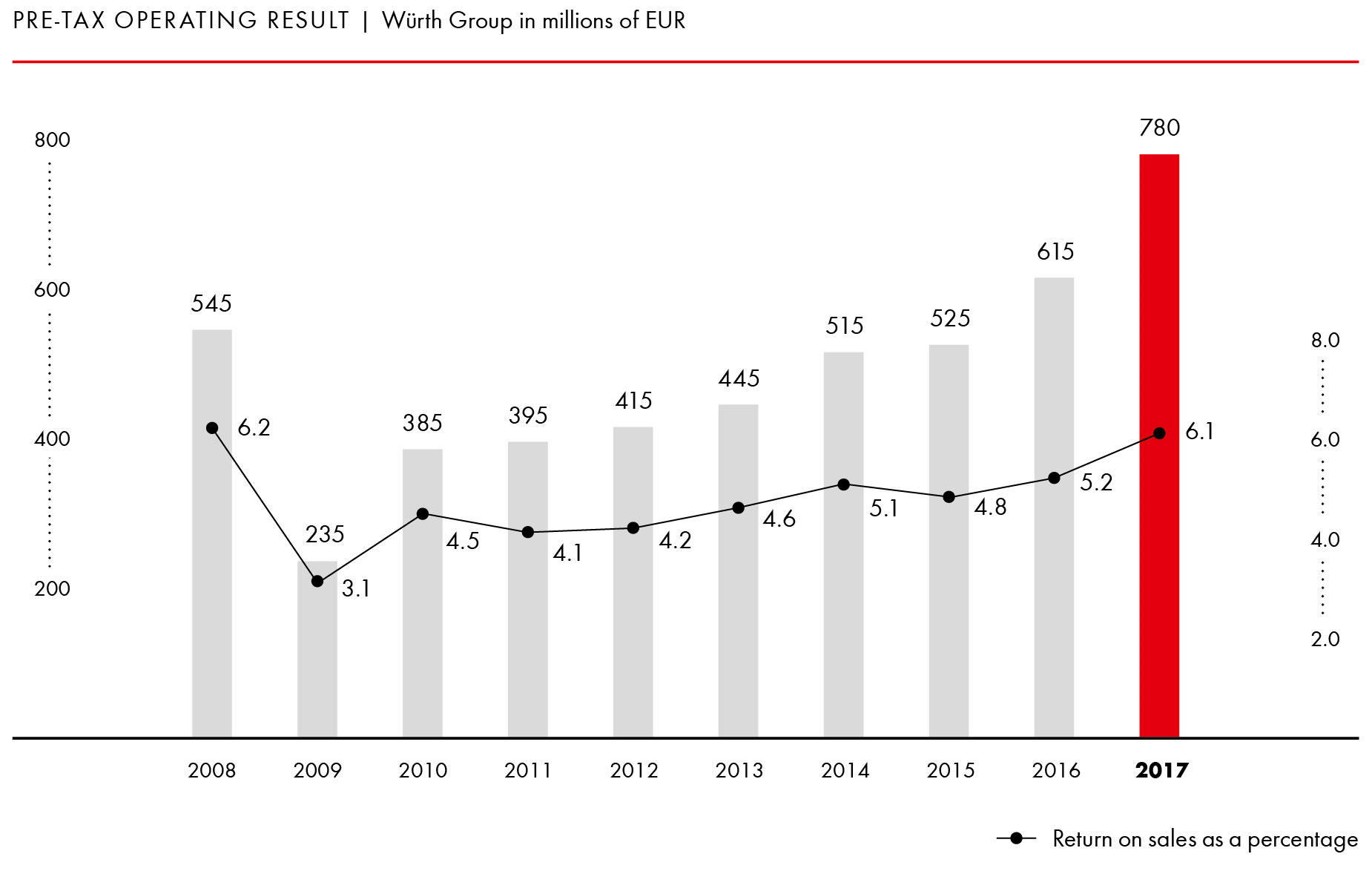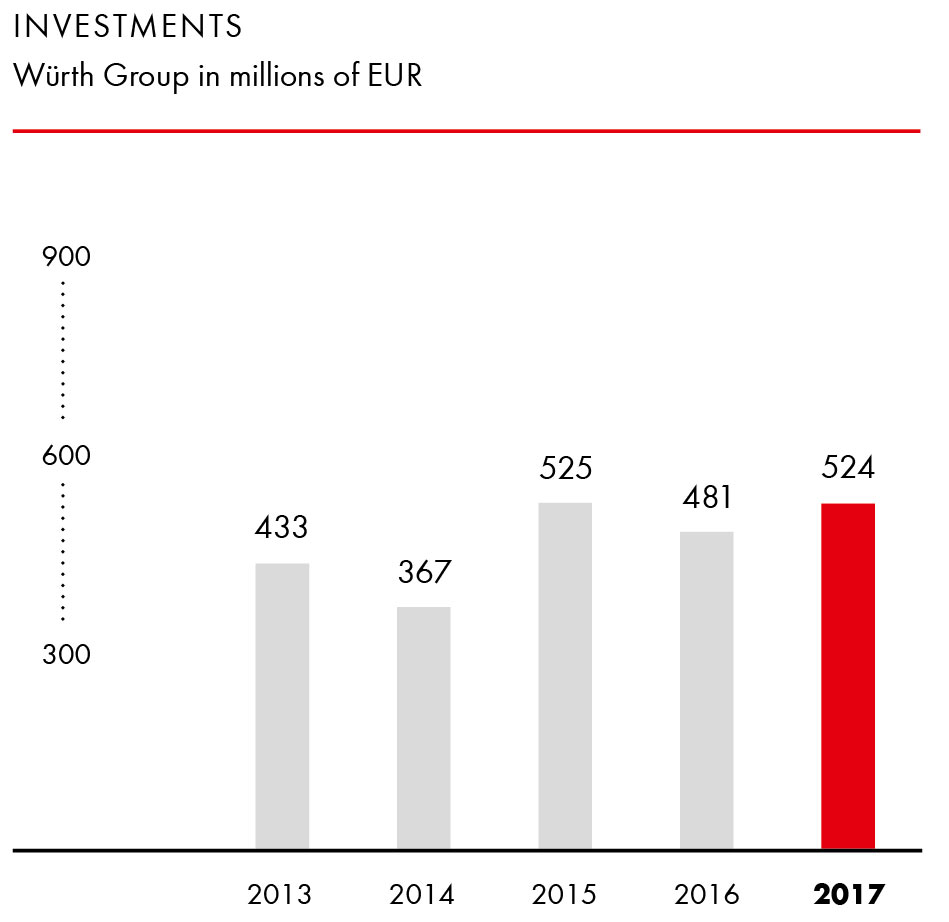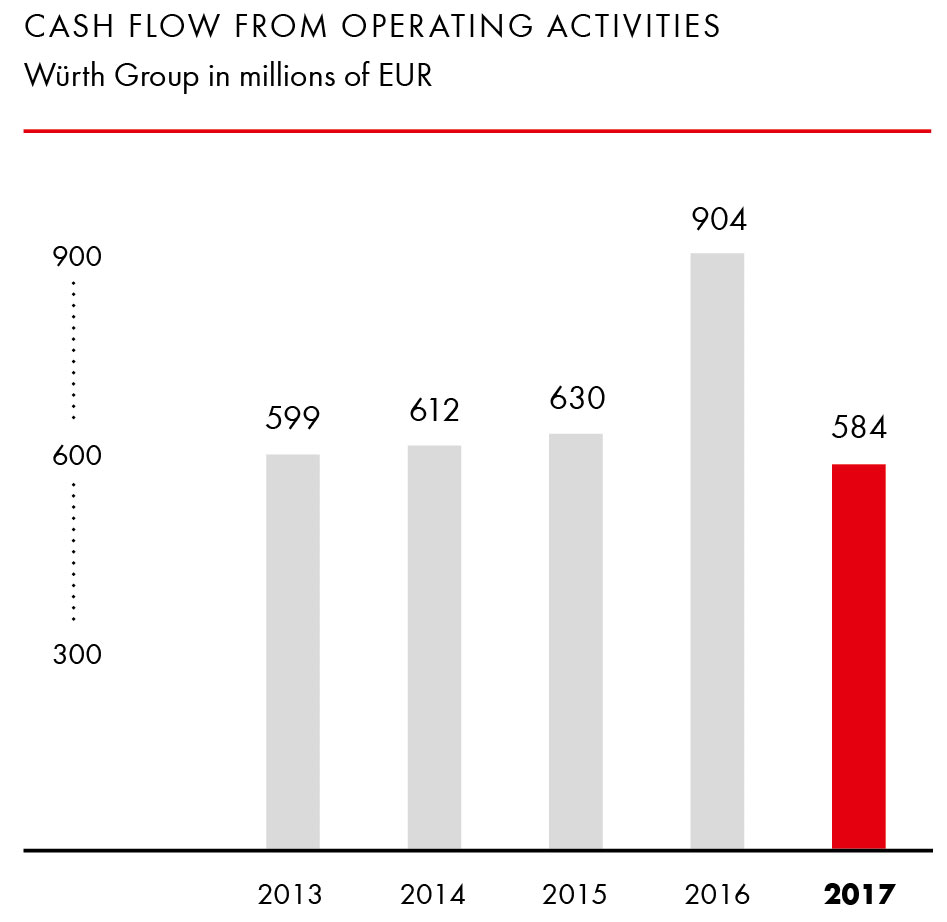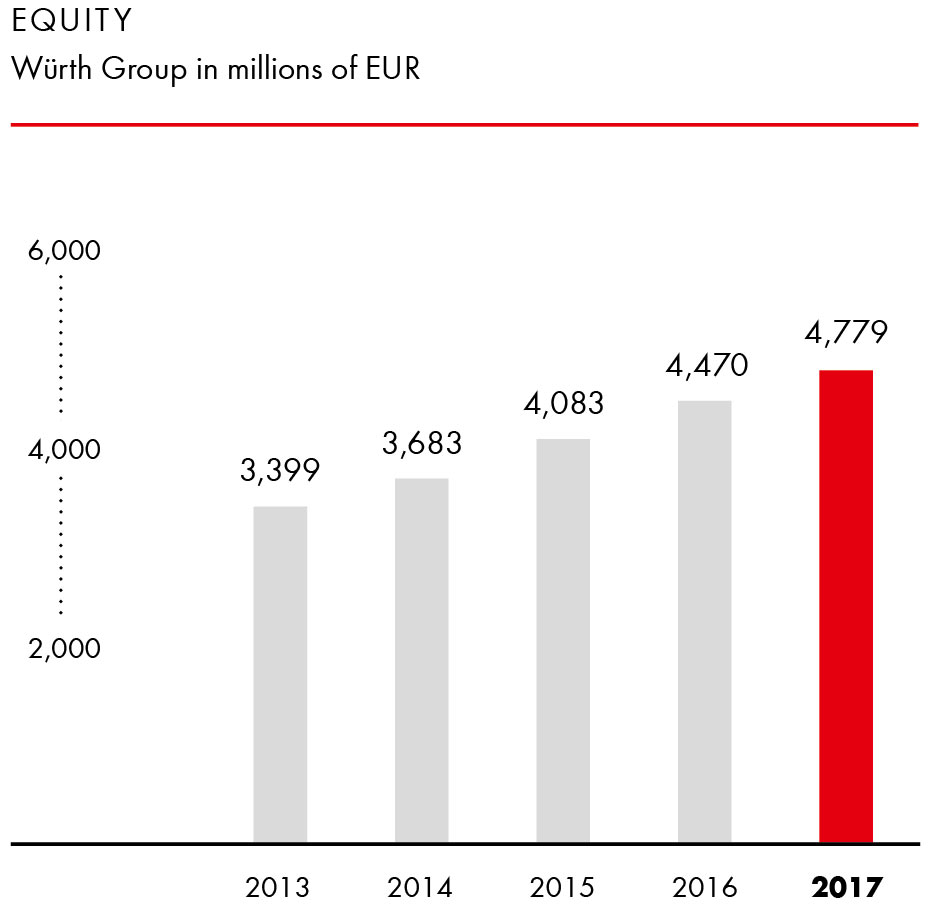- Clear increase in operating result
- Equity ratio of 46.5 percent
- Sustained high level of investment at over EUR 500 million

At EUR 780 million, the Würth Group achieved an absolute record operating result. This corresponds to a remarkable increase of 26.8 percent on the previous year, bringing the return up to 6.1 percent (2016: 5.2 percent). We have calculated the operating result as earnings before taxes, before amortization of goodwill and financial assets, before the collection of negative differences recognized in profit or loss, before the adjustment of purchase price liabilities from acquisitions through profit or loss, and before changes recognized in profit or loss from non-controlling interests disclosed as liabilities.
In Germany, the operating result rose by 19.9 percent to a record value of EUR 421 million (2016: EUR 351 million). The share of the Group’s overall result was 54.0 percent, with the return on sales increasing to 7.8 percent (2016: 6.9 percent). This improvement is largely attributable to Adolf Würth GmbH & Co. KG. The company that forms the core of the Group has been making by far the largest contribution to the result for years now. With an operating result of more than EUR 150 million, the Group’s flagship once again provided evidence of its earnings strength. Other top performers within Germany include: Würth Elektronik eiSos, Würth Industrie Service, Reca Norm and Arnold Umformtechnik.
The companies outside of Germany boosted their operating result by 36.0 percent to EUR 359 million (2016: EUR 264 million). This means that these companies showed much more dynamic earnings growth than a year ago, and also outstripped the earnings growth of the German companies. This momentum is due, first of all, to improved earnings at established companies such as Würth Finland. At the same time, the consolidation phase at Würth Italy has been completed. With a sales force of over 2,200, Würth Italy is one of the largest direct selling companies in the Group. The realignment resulted in a significant increase in earnings in 2017, also favored by productivity improvements. At the moment, we are still in the process of restructuring the direct sales business in China, Switzerland and the United Kingdom to achieve multi-channel distribution in order to pave the way for future profitable growth and efficient structures. The need for restructuring at individual industrial companies in the US also prevented even stronger earnings growth.
At 49.1 percent, the ratio of cost of materials to sales is on a par with the previous year (2016: 49.1 percent). It was impossible to reduce this ratio due to rising commodity prices.
At EUR 132 million, other operating income was down slightly on the previous year (2016: EUR 134 million). Remeasuring earn-out liabilities in the US industrial companies increased income by EUR 31.9 million. Lower insurance reimbursements at Würth Elektronik in Niedernhall, which were still being recognized in 2016 and were attributable to the fire at the PCB factory in December 2014, had the opposite effect. In addition, negative goodwill derecognized through profit and loss resulting from initial consolidation reduced income by EUR 17.0 million.
At the end of December 2017, the Würth Group had a total of 74,159 employees. The increase in the workforce by 2,768 compared with December 2016 was one of the reasons behind the sales growth that the company achieved, as face-to-face contact is the strength of our direct distribution approach. The sales forces work hand in hand with our highly effective in-house staff, who provide the necessary support for the specific sales strategy. 797 additional employees joined the sales team in 2017. The number of employees working as members of the in-house staff rose by 4.9 percent, or 3.5 percent after adjustments to reflect acquisitions. At 27.3 percent, the ratio of personnel expenses to sales improved compared with the previous year (2016: 27.7 percent).
At EUR 426 million, amortization and depreciation was up considerably on the prior year in 2017 (2016: EUR 345 million). Amortization and depreciation resulting from the investments made on the one hand, and from the acquisitions realized on the other hand, rose slightly compared with the previous year’s level. A major reason for the increase in amortization and depreciation in 2017 lies in the rise in impairment losses on goodwill relating to the US industrial companies.
Other operating expenses showed a below-average increase in relation to sales growth in a year-on-year comparison. The ratio was down on the previous year at 15.2 percent (2016: 15.8 percent). In the areas of rent and operating leases, as well as vehicle and travel expenses, the corresponding expenses increased at a lower rate, meaning that they contributed to an improvement in the ratio.
Net financing costs increased. This development was mainly due to exchange rate losses resulting from currency translation.
The tax rate increased in the 2017 fiscal year to 24.8 percent (2016: 22.5 percent). This is mainly due to the amortization of goodwill and other intangible assets that are not tax-deductible, mainly in connection with the increased impairment losses relating to the US industrial companies. For a detailed analysis, please refer to the consolidated financial statements: G. “Notes to the Consolidated Income Statement”, [9] “Income taxes”.
In the last fiscal year, the Würth Group reported sales of EUR 12.7 billion and an operating result of EUR 780 million, allowing it to set two new records and achieve its objectives. Net income for the year rose to EUR 531 million. Against the backdrop of the global economic developments, the Central Managing Board believes that these results are highly satisfactory. The main KPIs, such as sales and operating result, have improved. Our gross profit, i.e. sales minus the cost of goods sold, along with our staff turnover, inventory turnover and collection days, also improved or are at an acceptable level.

Capital expenditures and cash flow
Growth is inextricably linked to the self-image of the Würth Group. Growth by tapping into new markets and growth in existing markets require optimal overall conditions. One of the ways in which the Würth Group achieves such conditions is through sustainable investment. Over the past ten years, the Group has invested around EUR 4 billion. It has always been the Würth Group’s strategy to invest in sales-related and productive areas. In the last fiscal year, for example, investments in the amount of EUR 524 million (2016: EUR 481 million) focused on the expansion of IT infrastructure and warehouse capacities for our distribution companies, as well as on production buildings and technical equipment and machinery for our manufacturing companies. The Austrian company Grass GmbH, a development partner and system provider for the furniture industry, expanded its capacity for the successful Nova Pro product line, as well as for new product lines. The company invested a total of EUR 18.0 million in technical equipment and machinery.
The concept for logistics expansion at Fega & Schmitt had already been adopted by the end of 2016. The company is part of Würth’s electrical wholesaling business and is expanding its central warehouse in Heilbronn, which was commissioned in 2006 and has already reached its capacity limit due to the dynamic growth witnessed in recent years. The construction work, which started in 2017, is scheduled for completion in the second half of 2018. Halls measuring around 15,000 m² will be constructed on a total area of 50,000 m², with space for an additional 15,000 pallet storage spaces. Some of these spaces are connected directly, using modern conveyor technology, to a cable cutting center with six lines for customized cable assembly. The total amount being invested comes to around EUR 22 million.
Arnold Umformtechnik, which specializes in connecting and forming technology solutions for the automotive and electrical industry, laid the cornerstone for three further production sites, with corresponding machinery, in Dörzbach in April 2015. The focus is on process orientation and optimizing the production of branded products, as well as on finishing and the steps leading up to delivery. Part of the location strategy includes the construction of a new hardening plant. The aim is to reduce the steadily increasing costs for the outsourcing of hardened goods due to limited in-house capacities. The objective is also to shorten lead times and improve on-time delivery for the growing number of customer orders. The company will also benefit from the significant reduction in transfer logistics between the locations. This investment was given the green light at the end of 2017. The total investment volume comes to EUR 10.5 million.
In addition to the Allied Companies, the Würth Line companies also made substantial investments in stepping up their sales activities.
Würth Norway expanded its logistics capacity by more than 4,000 m². An automated warehouse was created as part of the expansion measures. The total cost of the project, which had already been launched in 2016, amounts to EUR 9.7 million.
Würth Industrie Service expanded its European logistics center in Bad Mergentheim. The new fully automated high-bay warehouse is 120 meters long and 45 meters high, making it one of the largest warehouses of its kind in the whole of Europe. The capacity has been increased by more than 49,000 pallet storage spaces to a current total of around 650,000 storage spaces. This allows Würth Industrie Service to offer maximum security for the supply of C parts for customers in more than 35 countries.
The official opening ceremony of the Carmen Würth Forum culture and convention center was held in Künzelsau-Gaisbach on 18 July 2017. Covering a total area of around 11,000 m2, the multifunctional event location features a large hall that can be subdivided with a capacity of 2,500 people, a chamber music hall with 580 seats, a gallery and a foyer, as well as space for open-air events. The total investment came to around EUR 60 million.
In addition to investments in production and storage space, we have also, as in past years, invested in our ORSY® storage management system, which offers our customers storage and provision options for various consumables and supplies in line with their needs.
In total, EUR 284 million, or 54.2 percent of the investment volume, was attributable to Germany, reflecting the continued paramount significance of the home market for the Würth Group.

Thanks to our efficient investment controlling processes using sophisticated recording and analysis tools, the Central Managing Board is always in a position to react quickly to changes in the overall environment. This is another reason why we once again met our objective of financing investments in intangible assets and in property, plant and equipment from our cash flow from operating activities in full in 2017. Our cash flow from operating activities came in at EUR 584 million (2016: EUR 904 million), down by 35.4 percent on the previous year. One reason for the marked drop in cash flow was the drive to accumulate inventories in order to ensure our ability to deliver in a period dominated by turbulent developments in the procurement markets. The increase in receivables from financial services has also had a negative impact on cash flow. On the one hand, the cash reserves of Internationales Bankhaus Bodensee AG were reduced to a lower level, while on the other, the bank’s lending business was expanded due to the abolition of the capital surcharge. After the high level of cash flows in 2016, which was influenced to a considerable degree by prior-period factors, this key figure has fallen significantly again. The financing of the investments made in 2017 in the amount of EUR 524 million required 89.7 percent of the operating cash flow (2016: 53.2 percent).
Purchasing
The purchasing manager’s index for the eurozone remained significantly above the 50-point expansion threshold in 2017, and touched on a new record high of 60.6 points at the end of the year. This economic indicator also showed positive development throughout the year in the US and China, highlighting the robust economic health of many industrial companies. As a result, the capacity utilization rate of our suppliers remained high in the 2017 fiscal year. The very positive order situation worldwide made many producers less flexible, resulting in significantly longer delivery times overall. Supply bottlenecks, in some cases extreme ones, for individual commodities meant that the delivery situation was extremely tense. The recent move by the Chinese authorities to step up their approach to environmental controls considerably exacerbated the tense situation on the Chinese procurement market, as it resulted in capacities no longer being available and pushed prices up accordingly.
After 2016 gave us largely good arguments for our price negotiations due to falling commodity prices, meaning that we were able to generate corresponding price savings by systematically exploiting these advantages, the tide turned dramatically at the beginning of 2017: Commodity prices exploded across the board and remained at a high level overall at the end of the year. As a result, the Würth Group was confronted with, in some cases, dramatic price increases in some areas of procurement. In this environment, and given the persistently high demand, we expect to see a further increase in purchase prices in 2018.
In order to optimize its master data management, the procurement function is working on establishing a harmonized supplier base within the context of the Würth Group’s IT strategy. This is designed to allow the individual Group companies to benefit from shared, harmonized and validated data, as well as from the tried-and-tested, standardized processes and structures of a central ERP system.
Inventories and receivables
As a company that largely operates in the trade sector, the Würth Group’s inventories and receivables are key balance sheet items, which the company’s management is continually seeking to manage and optimize. Both balance sheet items allow for short-term controlling and optimization of liquidity and tied-up capital in the Group. This involves striking the right balance between making sure that our customers are satisfied on the one hand – by offering the best delivery service and adequate payment periods – and optimizing the business-related key figures on the other hand.
The sales growth achieved in the 2017 fiscal year also pushed inventories and receivables up.
In 2017, the inventories of the Würth Group showed an above-average increase of 15.1 percent, rising by EUR 257 million to EUR 1,956 million. A small part of this increase (EUR 16.9 million) was the result of acquisitions. The much larger part can be attributed to purchases made to increase inventories due to the tense price and supply situation on the procurement market. In this currently very volatile market environment, establishing a good level of inventories affords the company a certain degree of security. We aim not only to satisfy our customers but also to inspire them. This involves achieving a service level that is close to the 100 percent mark. To achieve this, we were prepared to stock individual products in 2017, even where this runs contrary to all our business optimization efforts, in order to be able to deliver the goods to the customer one day after the order is placed at the latest. In 2017, we achieved this in 97 out of 100 cases. Despite this high service level, stock turnover, calculated on a 12-month basis, increased slightly from 5.0 times at the end of 2016 to 5.1 times.
Trade receivables rose by EUR 143 million to EUR 1,719 million (2016: EUR 1,576 million). This increase of 9.1 percent, which is slightly higher than the rate of sales growth, was due to the sales growth achieved in the last quarter of 2017 and partly to acquisitions. For years, sophisticated controlling systems, which enable rapid responses in the event of any indications of negative developments, and an optimum interplay between sales and accounts receivable management have enabled the Würth Group to achieve a low level of receivables in relation to sales. The corresponding key figure, collection days (based on a 12-month calculation), at 53.1 days could not, however, quite keep up with the level achieved in 2016 (52.6 days). We are nevertheless satisfied with the result, considering that the Würth Group has operations in more than 80 countries worldwide. In Germany, the key figure increased slightly to 41.7 days as compared to 41.5 days in 2016. Traditionally, collection days in Germany are lower than at the companies outside of Germany.
We will continue to optimize accounts receivable by means of effective cooperation between sales and accounts receivable management, as well as by refining our analyses. We see the payment patterns of debtor payments as critical in Eastern Europe, Southern Europe, China and India – which, on the one hand, slows growth and, on the other hand, reduces earnings due to an increasing need to recognize impairment losses.
The percentage of bad debts and the expenses from additions to value adjustments related to revenues fell slightly to 0.5 percent (2016: 0.6 percent).

Financing
The equity of the Würth Group climbed by 6.9 percent to EUR 4,779 million last year, which corresponds to an increase of EUR 309 million.
This translated into another improvement in the equity ratio, which is quite high for a trading company and came to 46.5 percent at the end of the year (2016: 46.1 percent). For years, a comfortable equity capitalization has been the basis for consistently high levels of financial stability and the solid financing of our group of companies, strengthening the customers’ and suppliers’ trust in the Würth Group. This is due to the typical family business approach of reinvesting a large portion of profits in the company. The high level of equity financing allows the company to be relatively independent of external capital providers.
Total assets rose by EUR 556 million to surpass the EUR 10 billion mark for the first time (2017: EUR 10,267 million, 2016: EUR 9,711 million). This increase of 5.7 percent was largely due to the increase in property, plant and equipment and trade receivables, as well as inventories. Net debt increased from EUR 813 million in 2016 to EUR 955 million in 2017 as a result. Financial services activities also contributed to the growth in total assets. Refinancing in the banking sector was mainly achieved through financial intermediaries and refinancing programs launched by the European Central Bank, while refinancing in the leasing segment was achieved mainly through the ABCP (Asset Backed Commercial Paper) program created especially for this purpose, as well as through non-recourse financing.
The Würth Group has undergone an annual rating process for more than 20 years now. The leading rating agency Standard & Poor’s once again confirmed the Würth Group’s “A /outlook stable” rating in 2017. This rating reflects the confidence that business and the financial KPIs will continue to develop successfully. The opportunities and potential of the Würth Group are viewed in a positive light. Our long history of good ratings not only documents the positive credit rating; at the same time, it is proof of the continuous and successful development of our corporate group and the stability of our business model.
At the end of the 2017 fiscal year, the Würth Group had three bonds issued on the capital market and one private placement. All covenants in this context have been observed. In 2018, 2020 and 2022, bonds worth EUR 500 million each will reach maturity, while the private placement of USD 200 million is set to reach maturity in 2021. The maturity profile is thus well balanced. For further details of the maturity profile and interest structure, please refer to the consolidated financial statements: H. “Notes on the consolidated statement of financial position”, [25] “Financial liabilities”.
As at 31 December 2017, the Würth Group had liquid funds of EUR 671 million (2016: EUR 874 million). In addition, the Group has a fixed credit line of EUR 400 million, which remains undrawn to date, provided by a syndicate of banks until July 2022. In order to refinance the bond that will mature in 2018, funds are likely to be raised on the capital market as part of the existing “Euro Medium Term Notes” program (EMTN program). This EMTN program, which was established in 2015, allows the Würth Group to strengthen the long-term financing and liquidity basis as a means for future growth opportunities and investments, and offers a high degree of flexibility for issuing bonds.


